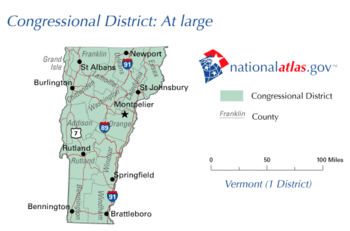| Vermont's at-large congressional district | |
|---|---|
 | |
| Representative | |
| Area | 9,620 sq mi (24,900 km2) |
| Distribution |
|
| Population (2023) | 647,464 |
| Median household income | $81,211[1] |
| Ethnicity |
|
| Occupation |
|
| Cook PVI | D+16[2] |
Vermont has been represented in the United States House of Representatives by a single at-large congressional district since the 1930 census, when the state lost its second seat, obsoleting its 1st and 2nd congressional districts. There were once six districts in Vermont, all of which were eliminated after various censuses.
Bernie Sanders (Independent) held the seat from 1991 until 2007, when he became a U.S. senator. Democrat Peter Welch, who succeeded Sanders in 2007, represented the state until 2023, when he was elected to succeed Patrick Leahy in the Senate. Progressive Democrat Becca Balint was elected to succeed Welch in the House for the 118th Congress. Balint is the first woman and LGBT person to represent Vermont, making Vermont the last state to be represented in Congress by a woman.
- ^ Center for New Media & Promotion (CNMP), US Census Bureau. "My Congressional District". www.census.gov. Retrieved September 22, 2024.
- ^ "2022 Cook PVI: District Map and List". The Cook Political Report. July 12, 2022. Retrieved January 7, 2023.